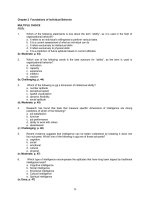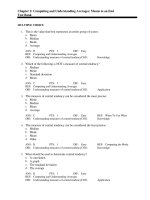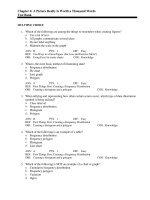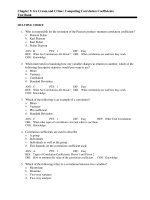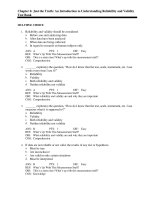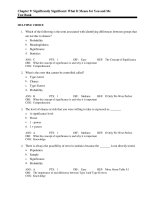Statistics salkind 4e test bank ch02
Bạn đang xem bản rút gọn của tài liệu. Xem và tải ngay bản đầy đủ của tài liệu tại đây (335.28 KB, 15 trang )
Chapter 2: Computing and Understanding Averages: Means to an End
Test Bank
MULTIPLE CHOICE
1. This is the value that best represents an entire group of scores:
a. Mean
b. Median
c. Mode
d. Average
ANS: D
PTS: 1
DIF: Easy
REF: Computing and Understanding Averages
OBJ: Understanding measures of central tendency COG:
Knowledge
2. Which of the following is NOT a measure of central tendency?
a. Median
b. Mode
c. Standard deviation
d. Mean
ANS: C
PTS: 1
DIF: Easy
REF: Computing and Understanding Averages
OBJ: Understanding measures of central tendency COG:
Application
3. This measure of central tendency can be considered the most precise:
a. Mode
b. Median
c. Mean
d. Average
ANS: C
PTS: 1
DIF: Easy
OBJ: Understanding measures of central tendency COG:
REF: When To Use What
Knowledge
4. This measure of central tendency can be considered the least precise:
a. Median
b. Mode
c. Mean
d. Other
ANS: B
PTS: 1
DIF: Easy
OBJ: Understanding measures of central tendency COG:
REF: Computing the Mode
Knowledge
5. What should be used to determine central tendency?
a. A correlation
b. A graph
c. The standard deviation
d. The average
ANS: D
PTS: 1
DIF: Easy
REF: Computing and Understanding Averages
OBJ: Understanding measures of central tendency COG:
Application
6. This consists of the middle point of a set of values:
a. Mean
b. Median
c. Mode
d. Other
ANS: B
PTS: 1
DIF: Easy
OBJ: Understanding measures of central tendency COG:
REF: Computing the Median
Knowledge
7. What is the most common average computed?
a. Mode
b. Mean
c. Variance
d. Median
ANS: B
PTS: 1
DIF: Easy
OBJ: Understanding measures of central tendency COG:
REF: Computing the Mean
Knowledge
8. What is the symbol used to represent the mean?
a. N
b. n
c.
d. X
ANS: C
PTS: 1
DIF: Easy
OBJ: Understanding measures of central tendency COG:
REF: Computing the Mean
Knowledge
9. What is another term for the mean?
a. Midpoint
b. Frequency
c. Arithmetic average
d. Distribution
ANS: C
PTS: 1
DIF: Easy
REF: And Now . . . Using Excel’s Average Function
OBJ: Understanding measures of central tendency COG:
Knowledge
10. What value is most often used to represent an entire group of scores?
a. Mode
b. N
c. Median
d. Mean
ANS: D
PTS: 1
DIF: Easy
OBJ: Understanding measures of central tendency COG:
REF: Computing the Mean
Knowledge
11. If a distribution is “significantly distorted,” what is this called?
a. Variability
b. Outliers
c. Skew
d. Percentile
ANS: C
PTS: 1
DIF: Easy
OBJ: Understanding measures of central tendency COG:
REF: Computing the Median
Comprehension
12. What is another way of describing “measures of central tendency”?
a. Statistical measures
b. Measures of variability
c. Averages
d. Deviation scores
ANS: C
PTS: 1
DIF: Easy
REF: Computing and Understanding Averages
OBJ: Understanding measures of central tendency COG:
Knowledge
13. What is the formula for computing the mean?
a. X + n
b. Y / X
c. X / n
d. N + y
ANS: C
PTS: 1
DIF: Medium
OBJ: Understanding measures of central tendency COG:
REF: Computing the Mean
Knowledge
14. This is calculated by multiplying values by the frequency of their occurrence, adding the total
of all the products, and then dividing by the total number of occurrences:
a. Mean
b. Arithmetic mean
c. Mode
d. Weighted mean
ANS: D
PTS: 1
REF: Computing a Weighted Mean
COG: Knowledge
DIF: Medium
OBJ: Understanding measures of central tendency
15. Which of the following symbols represents the individual score?
a. X
b. n
c. N
d.
ANS: A
PTS: 1
DIF: Easy
OBJ: Understanding measures of central tendency COG:
REF: Computing the Mean
Knowledge
16. What does the symbol represent?
a. The mean
b. The sum of values
c. The sample size
d. An individual score
ANS: B
PTS: 1
DIF: Easy
OBJ: Understanding measures of central tendency COG:
17. What is the name of the letter
REF: Computing the Mean
Knowledge
a.
b.
c.
d.
Phi
Rho
Sigma
Alpha
ANS: C
PTS: 1
DIF: Easy
OBJ: Understanding measures of central tendency COG:
REF: Computing the Mean
Knowledge
18. Which of the following symbols represents sample size?
a. X
b. y
c. n
d. M
ANS: C
PTS: 1
DIF: Easy
OBJ: Understanding measures of central tendency COG:
REF: Computing the Mean
Knowledge
19. What does the symbol M represent?
a. Population size
b. Sample Size
c. Mean
d. Individual score
ANS: C
PTS: 1
DIF: Easy
REF: And Now . . . Using Excel’s Average Function
OBJ: Understanding measures of central tendency COG:
Knowledge
20. If you know M = 5, and the sum of scores is 20, what is n?
a. 4
b. .25
c. 100
d. Need more information
ANS: A
PTS: 1
DIF: Medium
OBJ: Understanding measures of central tendency COG:
REF: Computing the Mean
Application
21. If X = 4,390 and n = 4, what is M?
a. 17,560
b. .0100
c. 1097.5
d. Need more information
ANS: C
PTS: 1
DIF: Medium
OBJ: Understanding measures of central tendency COG:
REF: Computing the Mean
Application
22. What is the mean value for the following scores: 10, 35, 40, 60, 55, 25, 50?
a. 45
b. 44.17
c. 40
d. 39.29
ANS: D
PTS: 1
DIF: Medium
OBJ: Understanding measures of central tendency COG:
REF: Computing the Mean
Application
23. What is the mean value of the following scores: 12, 25, 15, 27, 32, 8?
a. 19.83
b. 21.24
c. 20.00
d. 19.98
ANS: A
PTS: 1
DIF: Medium
OBJ: Understanding measures of central tendency COG:
REF: Computing the Mean
Application
24. What is the mean value of the following scores: 1.11, 1.17, 1.15, 2.02, 2.07, 3.11, 2.14?
a. 2.14
b. 2.07
c. 1.74
d. 1.82
ANS: D
PTS: 1
DIF: Medium
OBJ: Understanding measures of central tendency COG:
REF: Computing the Mean
Application
25. What is the mean value of the following scores: 117, 132, 147, 156, 196?
a. 151.2
b. 149.6
c. 147.0
d. 148.7
ANS: B
PTS: 1
DIF: Medium
OBJ: Understanding measures of central tendency COG:
REF: Computing the Mean
Application
26. Your current exam mean is 97.2. If you receive a 99 on the next exam, this will have the effect
of
a.
b.
c.
d.
Increasing your mean
Decreasing your mean
Having no effect on your mean
Cannot be determined
ANS: A
PTS: 1
DIF: Hard
OBJ: Understanding measures of central tendency COG:
REF: Computing the Mean
Analysis
27. Your current exam mean is 93.2. If you receive an 87 on the next exam, this will have the
effect of
a. Increasing your mean
b. Decreasing your mean
c. Having no effect on your mean
d. Cannot determine
ANS: B
PTS: 1
DIF: Hard
OBJ: Understanding measures of central tendency COG:
REF: Computing the Mean
Analysis
28. Your current exam mean is 95. If you receive a 95 on the next exam, this will have the effect
of
a. Increasing your mean
b. Decreasing your mean
c. Having no effect on your mean
d. Cannot be determined
ANS: C
PTS: 1
DIF: Hard
OBJ: Understanding measures of central tendency COG:
REF: Computing the Mean
Analysis
29. Which measure of central tendency is most influenced by outliers?
a. Median
b. Mode
c. Mean
d. Variance
ANS: C
PTS: 1
DIF: Easy
REF: And Now . . . Using Excel’s Median Function
OBJ: Understanding measures of central tendency COG:
Knowledge
30. What does the large N represent?
a. Sample size
b. Population size
c. Sum of scores
d. Mean score
ANS: B
PTS: 1
DIF: Easy
REF: And Now . . . Using Excel’s Average Function
OBJ: Understanding measures of central tendency COG:
Knowledge
31. What does the small n represent?
a. Sample size
b. Population size
c. Sum of scores
d. Mean score
ANS: A
PTS: 1
DIF: Easy
REF: And Now . . . Using Excel’s Average Function
OBJ: Understanding measures of central tendency COG:
Knowledge
32. Which measure of central tendency is also known as the midpoint for a set of scores?
a. Mode
b. Mean
c. Median
d. Sum
ANS: C
PTS: 1
DIF: Easy
OBJ: Understanding measures of central tendency COG:
REF: Computing the Median
Knowledge
33. For which of the following is the sum of the deviations from the mean always equal to zero?
a. Harmonic mean
b. Arithmetic mean
c. Standard deviation
d. Variance
ANS: B
PTS: 1
DIF: Hard
REF: And Now . . . Using Excel’s Average Function
OBJ: Understanding measures of central tendency COG:
Knowledge
34. What are Greek letters used to represent?
a. Population parameters
b. Sample data
c. Sample statistics
d. Outliers
ANS: A
PTS: 1
DIF: Easy
REF: And Now . . . Using Excel’s Average Function
OBJ: Understanding measures of central tendency COG:
Knowledge
35. The letter would be used to represent (a) _______.
a. Population parameter
b. Sample statistic
c. Inferential data
d. Outliers
ANS: A
PTS: 1
DIF: Medium
REF: And Now . . . Using Excel’s Average Function
OBJ: Understanding measures of central tendency COG:
Comprehension
36. What are Roman letters used to represent?
a. Population parameters
b. Sample statistics
c. Sample data
d. Outliers
ANS: B
PTS: 1
REF: Computing a Weighted Mean
COG: Knowledge
DIF: Medium
OBJ: Understanding measures of central tendency
37. The letter X with a bar over it is used to represent (a) _______.
a. Outliers
b. Sample statistic
c. Population parameter
d. Inferential statistics
ANS: B
PTS: 1
REF: Computing a Weighted Mean
COG: Knowledge
DIF: Medium
OBJ: Understanding measures of central tendency
38. Which of the following defines the median?
a. Sum of all values in a group
b. Most frequently occurring value
c. Average variability in a set of scores
d. Midpoint in a set of scores
ANS: D
PTS: 1
DIF: Easy
OBJ: Understanding measures of central tendency COG:
REF: Computing the Median
Knowledge
39. What is the median for the following amounts: $11.75, $12.75, $13.00, $10.75, $11.50,
$10.50, $10.75?
a.
b.
c.
d.
$11.50
$11.75
$11.57
$11.00
ANS: A
PTS: 1
DIF: Medium
OBJ: Understanding measures of central tendency COG:
REF: Computing the Median
Application
40. What is the median for the following amounts: $13,400; $17,560; $45,440; $68,550; $96,400?
a. $13,400
b. $48,240
c. $45,440
d. $96,400
ANS: C
PTS: 1
DIF: Medium
OBJ: Understanding measures of central tendency COG:
REF: Computing the Median
Application
41. What is the median of the following set of scores: 23, 17, 15, 32, 38, 47?
a. 23
b. 32
c. 17.4
d. 27.5
ANS: D
PTS: 1
DIF: Medium
OBJ: Understanding measures of central tendency COG:
REF: Computing the Median
Application
42. What is the median of the following set of scores: 1.3, 4.7, 2.3, 3.3, 3.0, 2.9?
a. 2.95
b. 3.05
c. 2.90
d. 3.00
ANS: A
PTS: 1
DIF: Medium
OBJ: Understanding measures of central tendency COG:
REF: Computing the Median
Application
43. When there is an even number of scores, how is the median calculated?
a. Average the two middle scores.
b. Use the smaller of the two middle scores.
c. Use the larger of the two middle scores.
d. The median cannot be calculated.
ANS: A
PTS: 1
DIF: Easy
OBJ: Understanding measures of central tendency COG:
REF: Computing the Median
Comprehension
44. With regard to percentile points, what is the median also known as?
a. Q1
b. Q2
c. Q3
d. Q4
ANS: B
PTS: 1
DIF: Easy
REF: And Now . . . Using Excel’s Median Function
OBJ: Understanding measures of central tendency COG:
Knowledge
45. What is the 25th percentile also known as?
a. Q1
b. Q2
c. Q3
d. Q4
ANS: A
PTS: 1
DIF: Easy
REF: And Now . . . Using Excel’s Median Function
OBJ: Understanding measures of central tendency COG:
Knowledge
46. What is the 75th percentile also known as?
a. Q1
b. Q2
c. Q3
d. Q4
ANS: C
PTS: 1
DIF: Easy
REF: And Now . . . Using Excel’s Median Function
OBJ: Understanding measures of central tendency COG:
Knowledge
47. Market researchers sent out a survey to college students in Ohio to assess their preferences in
regard to three different brands of honey. When examining the average preference of the
respondents, which measure of central tendency is most likely to be used to describe them?
a. Median
b. Mean
c. Mode
d. Cannot be determined
ANS: C
PTS: 1
DIF: Medium
OBJ: Selecting a measure of central tendency
REF: When To Use What
COG: Application
48. What impact do extreme scores have on the median?
a. Positive skew
b. Negative skew
c. Minimal impact
d. Nullify the value
ANS: C
PTS: 1
DIF: Medium
REF: And Now . . . Using Excel’s Median Function
OBJ: Understanding measures of central tendency COG:
Comprehension
49. Which of the following are used to define the percentage of cases equal to and below a certain
point in a distribution of scores?
a. T scores
b. Q points
c. Standard scores
d. Percentile points
ANS: D
PTS: 1
DIF: Easy
REF: And Now . . . Using Excel’s Median Function
OBJ: Understanding measures of central tendency COG:
Knowledge
50. A test score in the 97th percentile would be considered _______.
a. Very high
b. Very low
c. About average
d. Cannot be determined
ANS: A
PTS: 1
DIF: Medium
REF: And Now . . . Using Excel’s Median Function
OBJ: Understanding measures of central tendency COG:
Comprehension
51. A test score in the third percentile would be considered _______.
a. Very high
b. Very low
c. About average
d. Cannot be determined
ANS: B
PTS: 1
DIF: Medium
REF: And Now . . . Using Excel’s Median Function
OBJ: Understanding measures of central tendency COG:
Comprehension
52. A test score in the 47th percentile would be considered _______.
a. Very high
b. Very low
c. About average
d. Cannot be determined
ANS: C
PTS: 1
DIF: Medium
REF: And Now . . . Using Excel’s Median Function
OBJ: Understanding measures of central tendency COG:
Comprehension
53. If you were to calculate the average of individual income, and you found many extreme
scores, which measure of central tendency should be used?
a. Mean
b. Median
c. Mode
d. Standard error
ANS: B
PTS: 1
DIF: Medium
REF: And Now . . . Using Excel’s Median Function
OBJ: Selecting a measure of central tendency
COG: Application
54. If you were to calculate the average of individual income, and you found no outliers, which
measure of central tendency should you use?
a. Mode
b. Median
c. Mean
d. Other
ANS: C
PTS: 1
DIF: Medium
REF: And Now . . . Using Excel’s Median Function
OBJ: Selecting a measure of central tendency
55. What does the term skew mean?
COG: Application
a.
b.
c.
d.
Significantly distort
Divide
Add
Equalize
ANS: A
PTS: 1
DIF: Easy
REF: And Now . . . Using Excel’s Median Function
OBJ: Understanding measures of central tendency COG:
Knowledge
56. Which of the following sets of data illustrates skew?
a. 2, 3, 5, 7, 9
b. 450, 472, 523, 547, 601
c. 23, 37, 42, 51, 147
d. 12, 14, 15, 17, 19
ANS: C
PTS: 1
DIF: Medium
REF: And Now . . . Using Excel’s Median Function
OBJ: Understanding measures of central tendency COG:
Application
57. What would be your preferred measure of central tendency if you had the following data:
$32,400; $42,500; $47,250; $49,570; $145,850?
a. Mean
b. Median
c. Mode
d. Weighted mean
ANS: B
PTS: 1
DIF: Medium
REF: And Now . . . Using Excel’s Median Function
OBJ: Selecting a measure of central tendency
COG: Analysis
58. What would be your preferred measure of central tendency if you had the following data:
$31,550; $33,750; $34,700; $37,550; $39,275?
a. Mean
b. Mode
c. Median
d. Average
ANS: A
PTS: 1
DIF: Medium
REF: And Now . . . Using Excel’s Median Function
OBJ: Selecting a measure of central tendency
COG: Analysis
59. What would be your preferred measure of central tendency if you had the following data: 23
Americans, 57 Mexicans, and 14 Canadians?
a. Mean
b. Weighted mean
c. Median
d. Mode
ANS: D
PTS: 1
DIF: Medium
OBJ: Selecting a measure of central tendency
REF: Computing the Mode
COG: Analysis
60. What would be your preferred measure of central tendency if you had the following data: 57
males and 23 females?
a.
b.
c.
d.
Median
Weighted mean
Mean
Mode
ANS: D
PTS: 1
DIF: Medium
OBJ: Understanding measures of central tendency COG:
REF: Computing the Mode
Analysis
61. Which of the following best describes the mode?
a. Sum of all values in a group
b. Midpoint in a set of scores
c. Number of subject collected
d. Most frequently occurring value(s)
ANS: D
PTS: 1
DIF: Easy
OBJ: Understanding measures of central tendency COG:
REF: Computing the Mode
Knowledge
62. The mode will always consist of the following:
a. The number of cases in the category
b. The name of the category
c. The format of the category
d. The size of the category
ANS: B
PTS: 1
DIF: Easy
OBJ: Understanding measures of central tendency COG:
REF: Computing the Mode
Knowledge
63. What is the mode of the following data: 47 Republicans, 49 Democrats, and 52 independents?
a. 52
b. Republicans
c. Democrats
d. Independents
ANS: D
PTS: 1
DIF: Medium
OBJ: Understanding measures of central tendency COG:
REF: Computing the Mode
Application
64. What is the mode of the following data: 57 males and 43 females?
a. 57
b. Males
c. Females
d. Cannot be determined
ANS: B
PTS: 1
DIF: Medium
OBJ: Understanding measures of central tendency COG:
REF: Computing the Mode
Application
65. What is the mode of the following data: 52 bowls of spaghetti, 37 bowls of cereal, 14
sandwiches, and 17 personal pizzas?
a. Bowls of cereal
b. Sandwiches
c. 52
d. Bowls of spaghetti
ANS: D
PTS: 1
DIF: Medium
OBJ: Understanding measures of central tendency COG:
REF: Computing the Mode
Application
66. Which of the following represents a bimodal distribution?
a. 23 males and 14 females
b. 43 New Yorkers, 14 Kentuckians, and 7 Wyomingites
c. 23 professors and 22 researchers
d. 14 individuals with blonde hair and 8 individuals with brown hair
ANS: C
PTS: 1
DIF: Hard
REF: And Now . . . Using Excel’s Mode.SNGL Function
OBJ: Understanding measures of central tendency COG:
Application
67. When describing a set of nominal data, a researcher should use which of the following
measures of central tendency?
a. Mode
b. Median
c. Standard deviation
d. Mean
ANS: A
PTS: 1
DIF: Medium
OBJ: Selecting a measure of central tendency
REF: Computing the Mode
COG: Analysis
68. This is another word for a single observation:
a. A data point
b. Data
c. A sample
d. A population
ANS: A
PTS: 1
DIF: Easy
REF: Sigma Freud and Descriptive Statistics
OBJ: Understanding measures of central tendency COG:
Knowledge
69. Which of the following measures of central tendency is the least precise representation of a
group of scores?
a. Mode
b. Median
c. Mean
d. Average
ANS: A
PTS: 1
DIF: Easy
OBJ: Understanding measures of central tendency COG:
REF: Computing the Mode
Knowledge
TRUE/FALSE
1. While there are three measures of central tendency, the mean, median, and mode are all
interchangeable anyway.
ANS: F
PTS: 1
DIF: Easy
REF: Computing and Understanding Averages
OBJ: Understanding measures of central tendency COG:
Comprehension
2. A researcher should use the mode as a measure of central tendency when the data are
qualitative in nature.
ANS: T
PTS: 1
DIF: Easy
OBJ: Selecting a measure of central tendency
REF: When To Use What
COG: Comprehension
SHORT ANSWER
1. Why is the mean the most frequently used measure of central tendency?
ANS:
When the distribution of scores is free of outliers (i.e., extreme scores), the mean tends to be
the most precise measure of central tendency.
PTS: 1
DIF: Medium
REF: And Now . . . Using Excel’s Median Function
OBJ: Selecting a measure of central tendency
COG: Comprehension
2. What is the formula for calculating the mean? What does each of the symbols represent?
ANS:
X / n, where represents summation, X represents individual scores, and n represents the
sample size.
PTS: 1
DIF: Medium
REF: Computing the Mean
OBJ: Understanding measures of central tendency COG:
Knowledge
3. What is meant by the term outlier?
ANS:
An outlier refers to any extreme scores in a data set.
PTS: 1
DIF: Medium
REF: And Now . . . Using Excel’s Average Function
OBJ: Understanding measures of central tendency COG:
Comprehension
4. When might the median be the more appropriate measure of central tendency over the mean?
ANS:
When there are extreme scores in a distribution, calculating the mean would result in skewed
results. The median provides a more accurate measure of the average.
PTS: 1
DIF: Hard
REF: When To Use What
OBJ: Selecting a measure of central tendency
COG: Application
5. What does the term bimodal mean?
ANS:
Bimodal refers to a distribution of scores that has two different modes, or two scores that
occur most frequently.
PTS: 1
DIF: Medium
REF: Apple Pie a la Bimodal
OBJ: Understanding measures of central tendency COG:
Comprehension
6. When is the mode the best measure of central tendency to use?
ANS:
The mode should be used when working with categorical or nominal data (ex. gender).
PTS: 1
DIF: Medium
REF: When To Use What
OBJ: Selecting a measure of central tendency
COG: Application
7. How would you calculate a weighted mean?
ANS:
First, list all values in the sample. Second, list the frequency associated with each value.
Third, multiply the value by its frequency. Fourth, sum all “Value x Frequency.” Fifth and
finally, divide by total frequency or n.
PTS: 1
DIF: Hard
REF: Computing a Weighted Mean
OBJ: Understanding measures of central tendency COG:
Comprehension
